Section 1: Agency overview and resources
1.1 Strategic direction
The Corporations and Markets Advisory Committee (CAMAC) is constituted under Part 9 of the Australian Securities and Investments Commission Act 2001 (ASIC Act). Its functions, as reflected in paragraph 1(1)(c) and section 148 of the ASIC Act, are to provide informed and expert advice to the Government about corporate, financial product and financial market matters, on its own initiative or when requested by the Minister. CAMAC seeks to promote a sound and effective regulatory environment through the provision of timely advice to the Minister about relevant policy and law design issues.
CAMAC's members are appointed by the Minister following consultation with State and Territory Governments. CAMAC is supported by specialist legal advice from its Legal Committee and by a full-time executive located in Sydney.
In the 2011-12 financial year, CAMAC will settle its reports to the Government on the external administration of managed investment schemes and the definition of derivative and will also consider other aspects of the regulation of managed investment schemes.
CAMAC will also respond to other requests for advice from the Government and keep under consideration other areas that may be suitable for review.
1.2 Agency resource statement
Table 1.1 shows the total resources from all sources. The table summarises how resources will be applied by outcome and by departmental classification.
Table 1.1: Corporations and Markets Advisory Committee resource statement — Budget estimates
for 2011-12 as at Budget May 2011
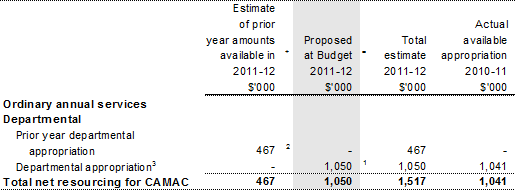
1. Appropriation Bill (No. 1) 2011-12.
2. Estimated adjusted balance carried from previous year for annual appropriations.
3. Includes $0.02 million in 2011-12 for the Departmental Capital Budget (also refer to Table 3.2.5 for further details).
1.3 Budget measures
Budget measures relating to CAMAC are detailed in Budget Paper No. 2, Budget Measures 2011-12 and are summarised below.
Table 1.2: Corporations and Markets Advisory Committee 2011-12 Budget measures

Prepared on a government finance statistics (fiscal) basis.
Section 2: Outcomes and planned performance
2.1 Outcomes and performance information
Government outcomes are the intended results, impacts or consequences of actions by the Government on the Australian community. Commonwealth programs are the primary vehicle by which government agencies achieve the intended results of their outcome statements. Agencies are required to identify the programs which contribute to Government outcomes over the budget and forward years.
CAMAC's outcome is described below, specifying the strategy, program objective, program deliverables and program key performance indicators used to assess and monitor the performance of CAMAC.
Outcome 1: Informed decisions by Government on issues relating to corporations regulation and financial products, services and markets through independent and expert advice
Outcome 1 strategy
To achieve its outcome, CAMAC will:
- conduct thorough research on matters under review, canvassing relevant law and policy considerations, with a view to preparing discussion papers where appropriate;
- consider submissions on discussion papers; and
- develop recommendations for inclusion in reports to the Government.
Outcome expense statement
Table 2.1 provides an overview of the total expenses for Outcome 1.
Table 2.1: Budgeted expenses for Outcome 1
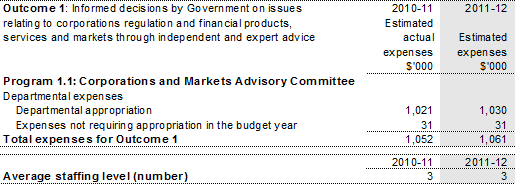
Contributions to Outcome 1
Program 1.1: Corporations and Markets Advisory Committee
Program objective
CAMAC focuses on legislation related to corporations and financial markets. Its operations involve, either on its own initiative or at the request of the Government, conducting major policy reviews, which may include analysing procedural and other issues in current practice. CAMAC:
- seeks to stimulate and lead public debate on the enhancement of standards for corporations and participants in financial markets, and proposes regulatory reform where necessary; and
- builds on the public consultation process by thoroughly reviewing all submissions on discussion papers and providing timely advice to the Government in the form of CAMAC reports, containing detailed law reform recommendations, where appropriate.
Program expenses
There are no significant changes to estimates across the forward years.
Table 2.2: Program expenses

Program deliverables
CAMAC's deliverables are the discussion papers and reports that it publishes on matters as they arise.
Program key performance indicators
CAMAC's key performance indicator is:
- timely advice to the Minister in the form of CAMAC reports and other papers.
Section 3: Explanatory tables and budgeted financial statements
Section 3 presents explanatory tables and budgeted financial statements, which provide a comprehensive snapshot of agency finances for the budget year 2011-12. It explains how budget plans are incorporated into the financial statements and provides further details of the reconciliation between appropriations and program expenses, movements in administered funds, special accounts and government Indigenous expenditure.
3.1 Explanatory tables
3.1.1 Movement of administered funds between years
CAMAC does not have any administered funds.
3.1.2 Special accounts
Special accounts provide a means to set aside and record amounts used for specified purposes. Special accounts can be created by a Finance Minister's Determination under the Financial Management and Accountability Act 1997 or under separate enabling legislation. Table 3.1.2 shows the expected additions (receipts) and reductions (payments) for each account used by CAMAC.
Table 3.1.2: Estimates of special account flows and balance
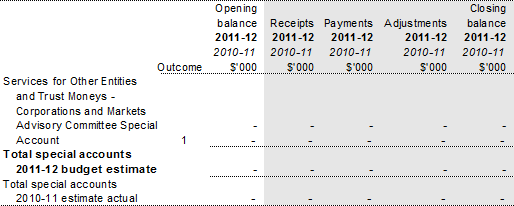
3.1.3 Australian Government Indigenous Expenditure
CAMAC does not have any Australian Government Indigenous Expenditure.
3.2 Budgeted financial statements
3.2.1 Differences in agency resourcing and financial statements
There are no differences between agency resourcing and financial statements.
3.2.2 Analysis of budgeted financial statements
CAMAC is budgeting for a break even result for 2011-12 and the forward estimates. This break even result will occur after adding back non-appropriated depreciation and amortisation expenses under the new net cash appropriation arrangements which were initiated in the 2010-11 Budget.
3.2.3 Budgeted financial statements tables
Table 3.2.1: Budgeted departmental comprehensive income statement
(for the period ended 30 June)

Prepared on Australian Accounting Standards basis.
Table 3.2.2: Budgeted departmental balance sheet
(as at 30 June)
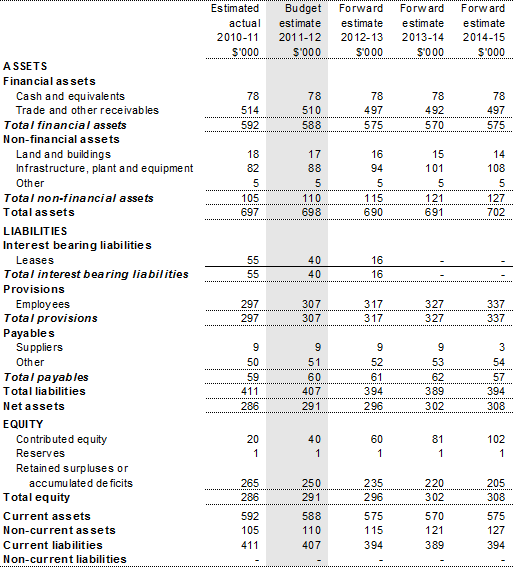
Prepared on Australian Accounting Standards basis.
Table 3.2.3: Budgeted departmental statement of cash flows
(for the period ended 30 June)
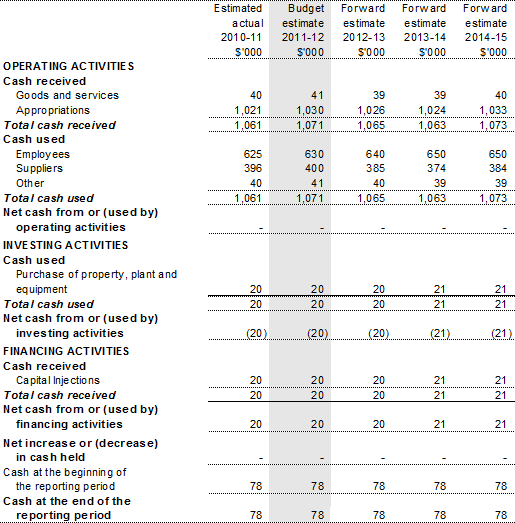
Prepared on Australian Accounting Standards basis.
Table 3.2.4: Departmental statement of changes in equity — summary of
movement (budget year 2011-12)
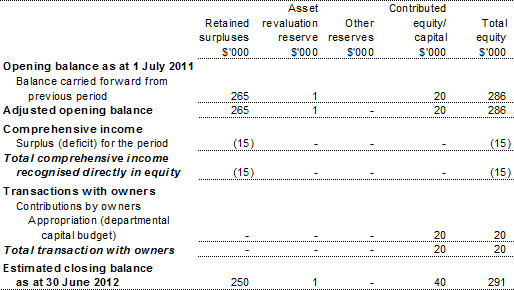
Prepared on Australian Accounting Standards basis.
Table 3.2.5: Departmental capital budget (DCB) statement
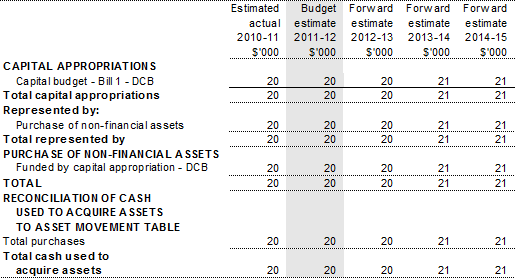
Prepared on Australian Accounting Standards basis.
Table 3.2.6: Statement of asset movements — departmental
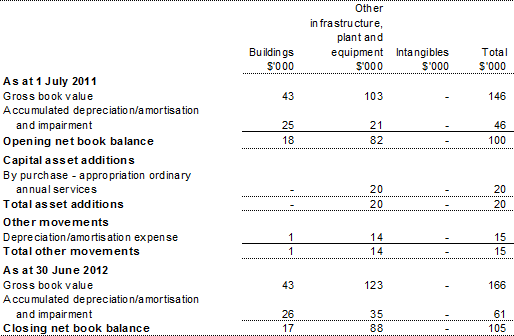
Prepared on Australian Accounting Standards basis.
3.2.4 Notes to the financial statements
The financial statements have been prepared on an Australian Accounting Standards basis.